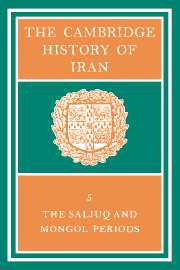Book contents
- Frontmatter
- 1 THE POLITICAL AND DYNASTIC HISTORY OF THE IRANIAN WORLD (A.D. 1000–1217)
- 2 THE INTERNAL STRUCTURE OF THE SALJUQ EMPIRE
- 3 RELIGION IN THE SALJUQ PERIOD
- 4 DYNASTIC AND POLITICAL HISTORY OF THE IL-KHĀNS
- 5 THE ISMĀ‘ĪLĪ STATE
- 6 THE SOCIO-ECONOMIC CONDITION OF IRAN UNDER THE ĪL-KHĀNS
- 7 RELIGION UNDER THE MONGOLS
- 8 POETS AND PROSE WRITERS OF THE LATE SALJUQ AND MONGOL PERIODS
- 9 THE VISUAL ARTS, 1050–1350
- 10 THE EXACT SCIENCES IN IRAN UNDER THE SALJUQS AND MONGOLS
- Bibliography
- Index
- Plate section
- References
3 - RELIGION IN THE SALJUQ PERIOD
Published online by Cambridge University Press: 28 March 2008
- Frontmatter
- 1 THE POLITICAL AND DYNASTIC HISTORY OF THE IRANIAN WORLD (A.D. 1000–1217)
- 2 THE INTERNAL STRUCTURE OF THE SALJUQ EMPIRE
- 3 RELIGION IN THE SALJUQ PERIOD
- 4 DYNASTIC AND POLITICAL HISTORY OF THE IL-KHĀNS
- 5 THE ISMĀ‘ĪLĪ STATE
- 6 THE SOCIO-ECONOMIC CONDITION OF IRAN UNDER THE ĪL-KHĀNS
- 7 RELIGION UNDER THE MONGOLS
- 8 POETS AND PROSE WRITERS OF THE LATE SALJUQ AND MONGOL PERIODS
- 9 THE VISUAL ARTS, 1050–1350
- 10 THE EXACT SCIENCES IN IRAN UNDER THE SALJUQS AND MONGOLS
- Bibliography
- Index
- Plate section
- References
Summary
In the religious history of Iran the Saljuq period is particularly interesting, for it is the period of the Ismā‘īlīs. As the Ismā‘īlīs movement is treated in another part of the book, this chapter will be chiefly devoted to the three main aspects of religious life in Iran during this period: the development of Sunnism, the ferment of Shī‘ī ideas, and Sūfism. Chronologically the Saljuq epoch in Iran extends roughly from the tenth to the twelfth centuries; obviously in this chapter we cannot always keep exactly within these limits.
If we realize that in the years from the death of Ash‘ari (935) to that of Ghazālī (1111) the entire theological system of Islam found its final systematization; that it was also the period of Nizām al-Mulk's Siyāsat-Nāma and of extremely interesting Shī‘ī–Sunnī polemics; and finally that in the twelfth century the oldest Shī‘ī–Sunnī(fraternities) were organized, some of the first great Muslim theological universities were founded, and the poet Nizāmī lived (1141–1209/13): realizing these facts, we can easily see the importance of the Saljuq era. Though not one of the most original, it is certainly one of the most formative epochs in the cultural history of Iran.
- Type
- Chapter
- Information
- The Cambridge History of Iran , pp. 283 - 302Publisher: Cambridge University PressPrint publication year: 1968
References
- 3
- Cited by

